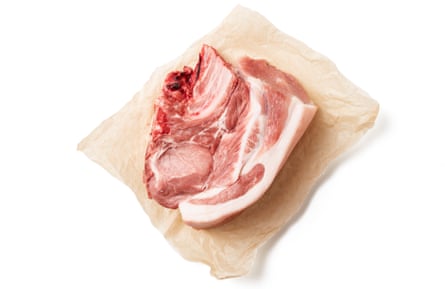
If you want the most perfect version of pulled pork, you’re going to need to dig a pit, stack it with well-seasoned wood and lovingly tend the fire for hours on end while the meat gently smokes – or visit the barbecue heartland of the southern US, where they’ll do it for you. This version, however, is about as good as you can get in a home kitchen.
Prep 15 min
Cook 7 hr+
Rest 30 min+
Serves 4
1.6kg bone-in shoulder of pork, from the neck end
2 tbsp salt
2 tbsp dark muscovado sugar
1 tbsp smoked paprika
2 tsp liquid smoke (optional)
1 dash cider vinegar (optional)
1 A note on the cut
Pulled pork is traditionally made with what is known in the US as Boston or pork butt, and is actually the top of the shoulder – “bone-in neck-end with a good layer of fat on top”, according to chef Neil Rankin – though, in practice, you’ll get good results from any bone-in shoulder with enough fat. Belly pork will also work, but will yield less meat.
2 Heat the oven to full whack
Pat the pork dry with kitchen towel and line a roasting tin with sheets of foil large enough to fold over the top of the meat (you’ll probably need two pieces set at right angles). Put the pork on top of the foil in the middle of the tin. Heat the oven as hot as it goes – that is, 240C (220C fan)/475F/gas 9.
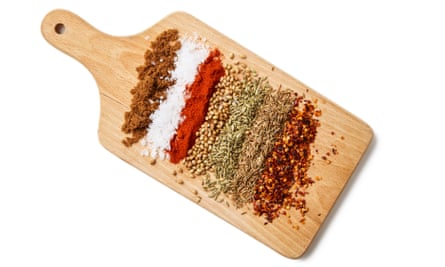
3 Make the rub
Mix the salt, sugar and smoked paprika, then divide roughly in half. Set one half aside and rub the other into the meat with your hands. Note that you can customise the spice rub as you wish, adding chilli, cumin, coriander, onion or garlic powder, ground fennel seeds or any other flavours you like with pork.
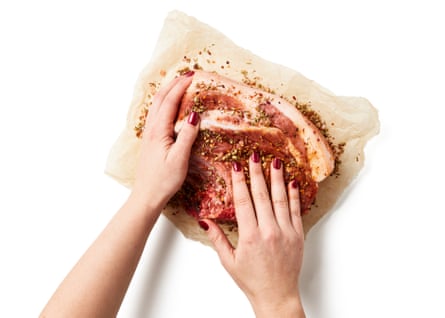
4 Roast the pork
Put the pork in the hot oven, leaving it uncovered for the moment, and roast for about 40 minutes, by which time it should be well browned on top; if at any point it looks like it’s burning, rather than browning, turn down the heat slightly and keep an eye on it.
5 Turn the oven down low
Take out the pork and turn the oven down to 140C (120C fan)/275F/gas 1. Pour the liquid smoke, if using, over the pork – this is easily available in specialist shops and online; it’s by no means mandatory, but it will help achieve that lovely barbecue flavour without the need for charcoal – then fold the foil over the top of the meat to make a sealed parcel.
6 Roast low and slow
Put the tin back in the oven and cook for six to seven hours, until and the meat is soft enough to spoon and/or the internal temperature of the pork measures at least 89C. (If you don’t have a cooking thermometer, this gives you ample time to go out and buy one, if your budget allows. Or, put one on your Christmas list; they’re a seriously useful piece of kit.)
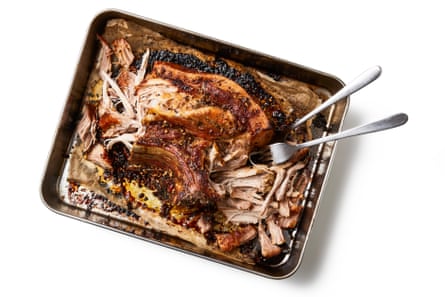
7 Brown, then rest
Uncover the pork, then pour the juices from the tin into a heatproof jug and set aside for now. Turn the oven back up to 240C (220C fan)/475F/gas 9 and cook the pork uncovered for another 10 minutes, to crisp up. Remove, cover and leave to rest for at least 30 minutes.
8 Shred the meat
Use two forks, or your fingers, to pull the meat into shreds, setting any crackling aside for now. Stir in the reserved half of the seasoning mix and the meat juices, plus a dash of cider vinegar, if you like it tangy, then cut the crackling into shards with scissors and arrange on top. If possible, leave to soak for a few hours before reheating.
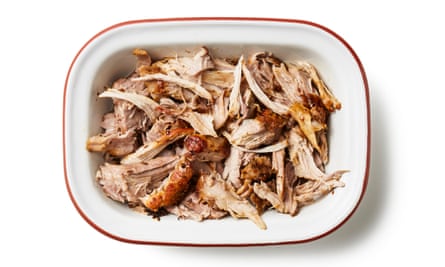
9 Serving suggestions
Classically served with soft white rolls, a sharp coleslaw, pickles, hot sauce or potato salad, pulled pork also pairs well with baked sweet potatoes and as a filling for tacos stuffed with shredded lettuce and beans and topped with soured cream. Leftovers, should you have them, are great scattered over nachos or bulked out with tomatoes and beans as a smoky stew to serve with rice.



